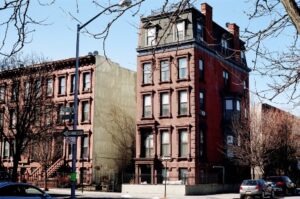Chicago's best property management company, providing tenant screening, rent collection, property marketing, and more at reasonable cost.
Forest Park Property Management at its best!
Three Pentacles is a trusted property management company in Forest Park, IL. Managing residential properties, commercial properties, HOA associations, and short-term vacation properties, Three Pentacles works hard to provide you with the customized property management service that works for you.
We Manage All Types of Properties in Forest Park
About Forest Park
For thousands of years, the Potawatomis and their ancestors lived in the area, which is now Forest Park. They buried their dead along the east bank of the Des Plaines River in the area that is at present, Forest Home Cemetery. Des Plaines Avenue is known to have been an Indian trail. It lies on top of an ancient sandbar that was on the western edge of Lake Chicago (now Lake Michigan) formed from the meltwater of the last glacier. After Illinois entered the Union, most of the land west of Chicago was set aside for veterans of the war of 1812. By 1835, the area was known as Oak Ridge because of the many native oaks.

In 1839 a French Indian trader, Leon Bourassa, received a land grant from President Martin Van Buren of 160 acres along the Des Plaines River north of what is now Roosevelt Road. By this time, the Indians had been banished to west of the Mississippi River, but one Indian maiden remained to tend the graves of her ancestors. According to legend, she married Leon and they settled here on land which is now part of Forest Home Cemetery. The deed for the government land Bourassa purchased was personally signed by President Martin Van Buren and is now kept in the Forest Park Library.
The railroad came in 1856 bringing with it a workforce who settled here thus claiming the date of the community’s first settlement as 1856. A German immigrant, Ferdinand Haase, purchased land in 1851 mostly from Bourassa, and built a home styled after the manors of New Orleans that he had seen. When he buried three members of his family near the homestead, they became the first white settlers to be interred here When the Chicago and Galena Union Railroad, (now the Northwestern) established a division where Des Plaines Avenue now approaches the track in 1856, it marked the beginning of public transportation in the area. Soon after the railroad arrived, a nearby landowner, John Henry Quick, gave part of the area a new name: Harlem, after his hometown in New York City. In the aftermath of the Chicago Fire in 1871, many refugees came to this community to build their homes. For several decades after 1880, a small excursion boat called the White Fawn took sightseers up and down the Des Plaines River. Docking facilities were at Haase Park, a popular picnic grove of the time.
In 1881 a small railway called The Dummy Line was built from Chicago’s west side to the cemeteries. Harlem School No.1 was the first school within the present boundaries of Forest Park. It grew to become the Grant-White School, still in its original location. The Altenheim-German Old People’s Home opened in 1885 and boasts the original Victorian building still in use. The building has been popular with Hollywood with no less than three movies using it as a location.
In 1973, 20th Century Fox used the Altenheim in a series of shots for the film “Harry and Tonto.” Art Carney, the film’s star, won an Oscar for his performance. In 1988, the building was used for exterior shots in the movie “The Package” with Gene Hackman. Finally, in 1995, the building was again used for exterior shots for the movie “The Babe” with John Goodman. Twenty gas streetlights were installed throughout town in 1886. They came complete with a lamplighter who received a salary of $12 per month. In the Waldheim Cemetery, now merged with Forest Home, are buried Albert Parsons, Adolph Spies, Adolph Fischer and George Engel. These four men were executed on November 11, 1887, for their alleged part in the Haymarket Riot. Waldheim, the only cemetery that would accept the bodies, hosted over 15,000 persons who attended the funeral. Governor John Peter Altgeld later exonerated the men and pardoned three others sentenced to life imprisonment. These seven soon became martyrs in the eyes of the labor movement. Ceremonies are now held at the gravesite each year honoring the fallen labor heroes.
A sausage factory started in 1890 by Karl Lau became the areas the first industry. The Metropolitan Westside “El” began electrified rapid transit service in 1895. Because it ran through Garfield Park, it became known as the Garfield Line. In 1897, the installation of electric lighting for “whomever desired this service,” was available to those living on or doing business on Madison Street. The telephone came in 1898. In 1898 Nicholas Shank built the very tall multistory building known as the Castle (at Harlem and Madison) which still stands. It was said to be the tallest building between Chicago and St Louis. By 1904, Henry J. Mohr served three terms as President of Harlem. After the Village changed its name to Forest Park in 1907, he served four more terms from 1909 through 1912. The office of President was then changed to Mayor in 1916 and, of course, Mohr was elected to yet another four years. This time, it became an extended period of six years because the election was not held at the proper time. Thus, Henry J. Mohr was the last President and the first Mayor of Forest Park, serving a record thirteen years as head of local government.
In 1907 the Forest Park Amusement Park opened. It was one of the most spectacular of its day featuring a roller coaster superstructure. Fifteen years later it succumbed to a devastating fire from which it never recovered. Vehicle tags made their appearance in 1908 after the Village Council passed a wheel tax ordinance to fund the repair and improvements of streets. To prove you paid your tax, all vehicles had to show a metal plate “attached to the right side of the vehicle or the horse.” The rates were $4 per one-horse vehicle and up to $24 for six-horse vehicles. A two-seat automobile paid $20, seats for three raised the price to $25. Woodlawn, Forest Park’s newest cemetery, was started in 1912. An interesting feature of Woodlawn is the plot on which the Showmen’s League of America buried fifty-three circus performers killed in a train wreck at Gary in 1918. Five granite elephants marking the boundaries of this unique section lent credence to the legend that the circus animals that perished were buried alongside their handlers. To this day, people swear that on certain nights they can hear the cries and calls from the ghosts of elephants and lions.
Just before 1912 the Harlem Golf Course was opened. It became known as the first and finest course in Chicago’s suburbs and the first public course to have creeping bent greens. In 1913 the first election was held under the new Commission form of government, which had been approved by voters in 1911 and had designated the presiding officer as Mayor (instead of President) for a four-year term. The vote for women came to Illinois in 1914. Albert Roos, a prominent citizen, urged them to exercise their franchise to defeat a referendum calling for the abolition of all Proviso Township saloons. As a result, saloons in Forest Park existed down to the present (though not during Prohibition).
In July of 1915, an excursion steamer capsized in the Chicago River claiming more than 800 lives. It was the worst maritime disaster ever seen and the largest loss of life since the Chicago Fire. Sixty of the victims, including one Forest Park resident are buried in Concordia Cemetery. The referendum calling for a free library was passed in 1916. Fifty people obtained library cards to access the 2200 books housed in two rooms of the Village Hall. Traffic lights came to Forest Park in 1925. Suddenly, people’s ability to travel at will was sharply curtailed. Two lights were suspended on cables over the intersection of Jackson and Des Plaines. When the light showed green for one street, it showed red for the other. Motorists and pedestrians alike were awe struck and surprised at the restriction to cross at will. The nearby Checkerboard Airfield (now Miller Meadow) built in 1918 was used regularly until 1927. It’s northern landing strip was used by the Chicago-St. Louis U.S. mail run, bringing a young Charles A. Lindbergh who rented a room here for his overnight stops. In the early 1930s, softball came to Forest Park. Emery Parichy brought the Boston Bloomer Girls, a championship softball team, and renamed them the Parichy Bloomer Girls. Some of the famous Bloomer Girls were paid as much as $5,000 per year, and others operated under contract, making them a truly professional sports team.
The ball team gave way to the Eisenhower Expressway in 1955 but left its legacy of championship softball which we still enjoy today. The earliest organized evidence of community interest in forming a park was in 1920 when the Forest Park Citizen’s Protective League was formed to prevent the development of the land for industry with the hope that it would someday become a park. Up through 1920, the land was little more than a huge vacant lot of grass, weeds and trees. It took a long time, but by 1934 the Village passed a referendum creating the Park District of Forest Park. The Park District purchased its first 14 acres of land the following summer, for $80,000. Administrative offices were opened in August.
The Great Depression was beginning to deepen and a new administration in Washington D.C, under Franklin D. Roosevelt, desperately tried to put people back to work. The WPA (Works Progress Administration) came to Forest Park to build pathways, tennis courts, baseball diamonds, a swimming pool and the imposing, English Tudor – styled administration building that still dominates the District’’ grounds on Harrison Street. The US Naval Ordinance Plant (Amertorp) began operations in 1942 and met armament needs for the nation through three wars. Thousands of torpedoes for the sinking of enemy ships were manufactured here until 1971. Around 1950, plans were underway for construction of the Congress Expressway, now the Eisenhower. Numerous Forest Park buildings were moved or demolished, and a large portion of Concordia Cemetery was moved to make way for progress.
Mike Todd, producer of theater and film and third husband of Elizabeth Taylor, and second husband of Joan Blondell was buried in Forest Park’s Jewish Beth Aaron Cemetery in March 1958. His widow, Miss Taylor is alleged to come every year in March to visit his grave. Whether true or not, fresh flowers mysteriously appear on his grave every anniversary of his death. He was buried under his original name, Avrom Goldbogen, in one of the largest funerals Forest Park has ever seen. Other nationally known persons buried in the present Forest Home Cemetery include Billy Sunday, the great evangelist; Charles Chamberlain, composer of lyrics to the Illinois State Song; Souy Smith, a Civil War brigadier general and engineer who developed “floating” foundations used in building the Elevated Railway System and by renowned architect, Dankmar Adler.
Other persons of note include gypsy Kings and Queens. A tragic event happened one night in July of 1960. A Sikorsky S-58 helicopter, flying between Midway and O’Hare Airports, exploded and crashed in Forest Home Cemetery. Thirteen died in this first-ever crash of a Sikorsky in the U.S. On July 30, 1960, the final segment of the Congress Expressway was opened between Des Plaines and First Avenue. It soon became the world’s busiest six-lane expressway. Howard R. Mohr was elected Mayor in 1963 and reelected twice again in 1971 and 1975. In between those times he represented his district as State Senator for three terms, 1966, 1970, and 1972. Forest Park’s famous Oktoberfest began in 1966 as part of a Madison Street promotion. Since the main event began on Friday, the Msgr. of the Roman Catholic Church gave a special dispensation so everyone could enjoy the German sausages along with the beer and oompah band. In 1969 the Kidney Dialysis Center opened in the parish hall of St. Peter Lutheran Church. It was the first in the world located on church property and one of the first to be located outside of a hospital. In an area near the monument marking the graves of the 1887 Haymarket Riot martyrs, is what has become known as Dissenter’s Row. Here lie the remains of men and women whose views and opinions were unpopular in their time.
In 1972 matching monuments were placed over the remains of eight of these dissenters. Among the socialists, communists, labor leaders and IWW organizers, buried here are Eugene Dennis, Emma Goldman, Dr. Ben Reitman, Elizabeth G. Flynn, William Foster, Frank Pelligrino, Jack Johnstone, Carl Wagenknecht and others with marked, and a few unmarked graves. Labor organizers Bill Hayward and Joe Hill requested their ashes be scattered near the Haymarket Monument. Catherine Buckley was elected a Village Commissioner in 1975. She was the first woman to hold such a position in Forest Park government.
We understand the ins and outs of local real estate
Need Help? Inquire About Our Management Services Here
Are you maximizing your rental property’s potential?




